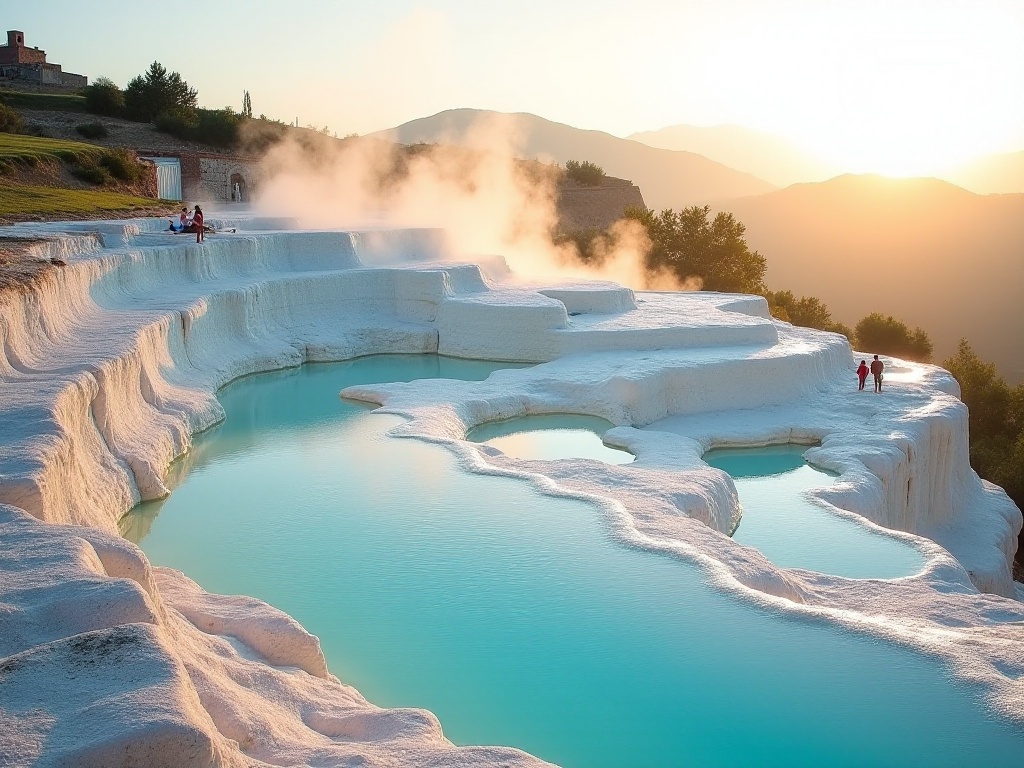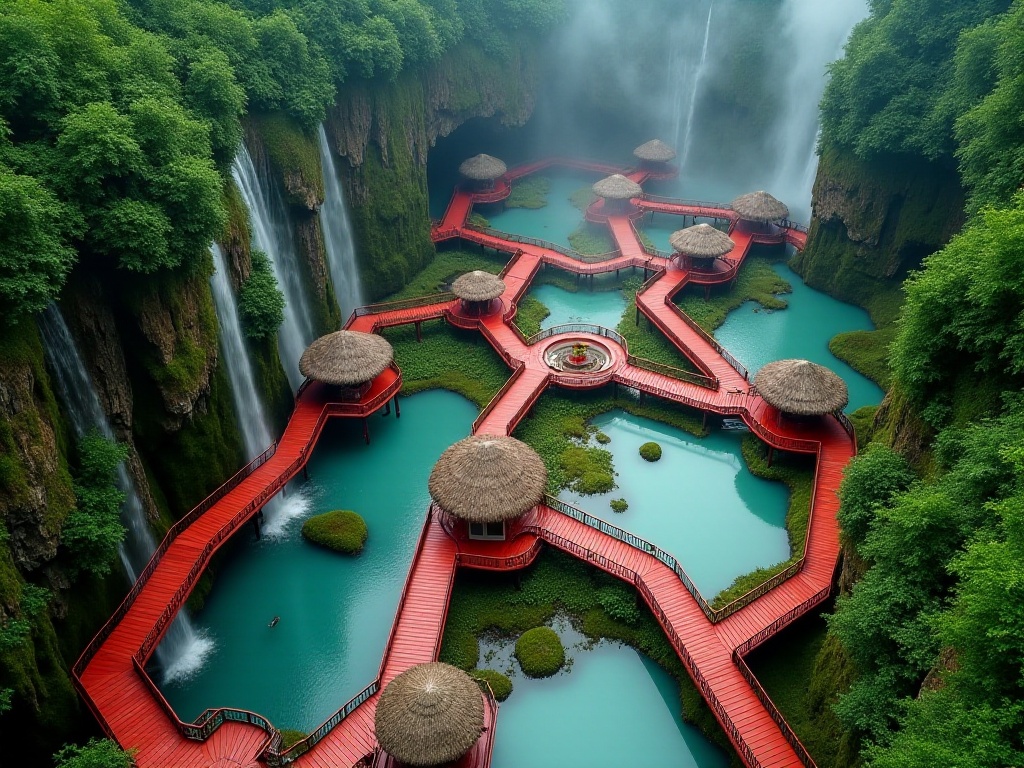Opening Chat
It's been freezing cold lately - getting out of bed feels like being a frozen popsicle. In weather like this, who wouldn't want to soak in a hot spring? As a seasoned hot spring enthusiast who has "soaked" around the world, I truly understand this feeling. Today, I'll take you on a tour of hot spring destinations worldwide. I guarantee that after reading this article, you'll be booking your tickets right away!
Land of Ice and Fire
To be honest, when I first heard about going to hot springs in Iceland, I was completely baffled. Soaking in hot springs in sub-zero temperatures? Was this a joke? But after actually going there, I understood what "paradise on Earth" truly means.
Iceland itself seems like a joke played by nature - a cold country covered in ice and snow, yet boiling hot underneath. Their geothermal resources are enviably abundant, with natural hot springs scattered throughout the country.
The Blue Lagoon is definitely Iceland's Instagram-famous spot, super convenient to reach from the airport. I remember my first visit - still groggy from the flight, but the moment I arrived at the Blue Lagoon, I was speechless with amazement. The scene was absolutely incredible: imagine standing in pure white snow, facing an impossibly blue pool of hot spring water, with white mist floating on the surface and snow-capped mountains in the distance. Just thinking about this scene feels magical.
Soaking in the Blue Lagoon is even more amazing. The water temperature is perfect, between 38-40 degrees Celsius, making your whole body feel wonderfully warm. The most magical experience is bathing during snowfall - your body in warm water while feeling snowflakes gently landing on your face creates an addictive contrast. The Blue Lagoon's water is actually a byproduct of a geothermal power plant, but don't think it's industrial waste - it's rich in silica, sulfur, and other minerals, leaving your skin silky smooth after bathing, better than any spa treatment.
I strongly recommend trying the face mask at the Blue Lagoon - the white silica mud mask. Though it looks a bit scary when applied, your skin becomes super hydrated afterward. I remember the first time I used it, a group of foreigners was secretly observing me, and after seeing my results, they all rushed to buy it too.
Besides the Blue Lagoon, Iceland has many lesser-known hot springs. For example, Mývatn Nature Baths, though not as famous as the Blue Lagoon, has fewer crowds, lower prices, and equally stunning scenery. There's also the Secret Lagoon, Iceland's oldest swimming pool dating back to 1891. While soaking there, you can watch small geysers erupting nearby - it feels like being in a fairy tale.
By the way, there's a very important rule when bathing in Icelandic hot springs: you must shower first! Icelanders are very particular about hygiene, and everyone must thoroughly clean themselves before entering the springs. I almost made this mistake my first time, thankfully a kind local reminded me.
An interesting aspect of Icelandic hot springs is that many are outdoor pools. You might think outdoor bathing in sub-zero temperatures would be cold, but it's not at all. The water temperature is high enough, and most springs have wind barriers. In fact, outdoor bathing is more exciting, especially during aurora season - soaking while watching the Northern Lights, well, I won't say more to avoid making you jealous.

Gentle Japanese Rain
From cold Iceland to four-season Japan, hot spring culture offers a completely different experience. In Japan, hot spring bathing is a profound art, with specific etiquette for every step from removing shoes to changing clothes, washing, and entering the bath. My first visit to a Japanese hot spring turned into quite a comedy - I tried to jump in wearing a swimsuit and was politely escorted to the changing room to "start over."
When it comes to Japanese hot springs, Arima Onsen is absolutely my favorite. This hot spring town in Kobe is considered the oldest in the Kansai region. Its most distinctive features are the "Kinsen" (Golden Spring) and "Ginsen" (Silver Spring). The Kinsen water is brownish, rich in iron and salt, reportedly effective for arthritis and skin conditions. When I first saw the Kinsen, I thought the water was dirty, but after bathing, my skin became incredibly smooth - then I understood why Japanese people value this place so much.
The Ginsen is completely different in style, with clear, colorless water containing carbonic acid and radium. Soaking in the Ginsen creates a slight tingling sensation, especially in areas with stronger water flow, making it feel like all your pores are opening up. The most amazing thing is that these two types of springs are just a few hundred meters apart - truly a masterpiece of nature.
At Arima Onsen, my favorite is the outdoor hot spring at night. Japanese people call outdoor hot springs "rotenburo." I remember once bathing in an outdoor spring on a rainy evening, surrounded by a traditional Japanese garden, listening to raindrops falling on bamboo leaves - truly an unforgettable experience.
Yufuin Onsen represents another style. This hot spring town in Kyushu has a particularly quiet and peaceful atmosphere. What shocked me most was the water temperature - it can reach 98 degrees Celsius! I couldn't believe it at first, thinking it would cook people, but later learned that this high-temperature spring water is specially treated to cool it down before guest use.
Yufuin is most beautiful at dawn, when the whole town is shrouded in mist and Mount Yufu appears and disappears in the distance. I specifically booked a room with a private outdoor bath to see this scenery. Waking up at five in the morning, soaking in the hot spring while watching the sunrise, seeing the sun slowly rise behind the mountain, the mist gradually clearing as the whole town awakens - that feeling is truly priceless.
In Yufuin, besides hot spring bathing, there are many interesting experiences. For example, "jigoku-mushi" involves cooking food with hot spring steam. I tried eggs cooked this way - they had a uniquely delicious taste, completely different from regular eggs. There's also "ashiyu" - small hot springs just for foot bathing. When tired from shopping, soaking your feet in an ashiyu can really revitalize you.
An interesting aspect of Japanese hot spring culture is time segregation. Many hot springs alternate between male and female access at different times, allowing everyone to experience the best pools. However, more hot springs now offer private baths for couples or families to enjoy together.
Speaking of Japanese hot springs, we must mention bathing etiquette. First, you must clean your body thoroughly before entering the spring. Japanese hot spring facilities usually provide washing areas where you must sit, not stand, while washing. Then, towels shouldn't be put in the spring water - they're usually folded and placed on your head. Most importantly, maintain quiet - no loud noises, as this is basic respect for other bathers.

Natural Wonder
Turkey's Pamukkale hot springs are absolutely the most dreamlike hot spring landscape I've ever seen. Honestly, when I first saw photos of Pamukkale, I thought they were Photoshopped. Only after seeing it in person did I realize such beautiful places really exist in this world.
Pamukkale consists of 17 terraced thermal pools that truly look like a castle made of cotton from afar. These pools formed over thousands of years from calcium carbonate deposits in the thermal waters - completely natural formation, which is amazing to think about. Each pool varies in depth and size, with water temperatures ranging from 35 to 100 degrees Celsius.
I was particularly lucky on my visit to Pamukkale - it was a sunny day. The sunlight reflecting off the white limestone created dazzling sparkles, making the entire spring complex look like it was sprinkled with diamond dust. Most magical were the water colors - due to varying mineral content, looking down from above, each pool had a different color, from light green to deep blue, some even with a hint of light purple, like a natural watercolor painting.
The experience of bathing in Pamukkale is also special. Being outdoors, you can enjoy the surrounding scenery while soaking. The most interesting part is that you can move from one pool to another, each with different temperatures and mineral content - it feels like playing an exploration game with hot springs.
What shocked me most was its history. Since ancient Roman times, this has been a favorite resort for nobles. Above the thermal area, ruins of the ancient Roman city of Hierapolis still remain. Imagine - Romans over two thousand years ago might have bathed in the same spot, looking at the same scenery. This sense of time travel is truly remarkable.
However, when visiting Pamukkale's hot springs, note that the travertine pools can be slippery. It's recommended to wear non-slip sandals and walk carefully. Also, since it's outdoors, sun protection is essential. Though soaking in water feels cool, Turkey's sun can be intense.
Most interestingly, Pamukkale's spring water is drinkable! The water is reportedly rich in calcium and other minerals, beneficial for health. I tried a small sip - it tastes like mineral water but sweeter. However, before drinking, it's best to ask guides or staff which pools are safe for drinking.

New World
When talking about American hot springs, many might think of Yellowstone's geysers. But in Arkansas's Ouachita Mountains, there's a place called "Hot Springs" that offers an equally impressive hot spring experience.
What's special about Hot Springs is how it completely breaks the traditional image of hot spring destinations. It's not just a single-purpose hot spring area, but a comprehensive resort that perfectly combines hot springs, natural scenery, and entertainment. You can soak in hot springs in the morning, climb Mountain Tower for views in the afternoon, and experience horse racing at the track in the evening.
The hot spring facilities here are unique. Many preserve their late 19th/early 20th century architectural style, making you feel like you've stepped back into America's Golden Age. I particularly love Quapaw Baths, a vintage-domed bathhouse with four different temperature pools ranging from 95 to 104 degrees Fahrenheit, allowing you to choose based on preference.
Most memorable was Buckstaff Bathhouse, operating since 1912 and still using traditional thermal treatments. You can experience traditional mineral baths, steam baths, and even hot spring massages. Though facilities might not be as luxurious as modern spas, this authentic experience is truly precious.
Hot Springs is unique as America's only urban national park. This means you can enjoy not just hot springs but various outdoor activities. The park has 47 springs and over 40 kilometers of hiking trails. I especially recommend Hot Springs Mountain Trail - not too challenging but offering panoramic views of the entire area.
In Hot Springs, you can visit the hot spring museum to learn about local history. Since the 19th century, this has been a favorite resort for American high society. Many celebrities, including several presidents, have bathed here. The museum preserves many interesting historical photos and artifacts - looking at these old photographs, you can almost feel the area's past prosperity.
Most interestingly, Hot Springs has many free thermal water collection points. You can bring containers to take spring water home. Locals say the water is safe to drink and beneficial for health. I tried the spring water - about 40 degrees Celsius, tasting like heated mineral water but sweeter.

Final Thoughts
Honestly, writing this article has sparked my own desire to go hot spring bathing. Each location has its unique charm - some known for extraordinary geographical features, others for long cultural traditions, and some for special health benefits.
Hot spring bathing isn't just a leisure activity; it's a window into local culture. Like how Japanese hot springs reflect their meticulous approach to life, Pamukkale carries traces of ancient civilization, and Iceland's Blue Lagoon showcases nature's masterwork.
Each hot spring experience is unique, just like each spring has its own character. Sometimes it's watching stars from a steaming pool on a cold winter night; sometimes it's enjoying solitude in morning mist; sometimes it's chatting and laughing with friends while soaking.
This is the charm of hot springs - they relax not just your body but also soothe your soul. So, if you haven't properly experienced hot springs yet, I really recommend finding time to try this unique pleasure. Trust me, once you fall in love with hot spring bathing, you can't quit.
If you have favorite hot spring destinations, please share in the comments. Next time we'll discuss the best seasons to visit different hot spring locations - looking forward to hearing your experiences!







